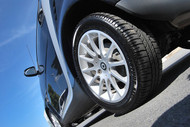Disc vs Drum Brakes: What's the Difference?
6th Jul 2023

Do you know the difference between disc and drum brakes? All cars, trucks and SUVs have brakes. Brakes are responsible for providing the "stopping" power when you press the brake pedal. While some vehicles use disc brakes, however, others use drum brakes.
What Are Disc Brakes?
Disc brakes are characterized by the use of platter- or disc-shaped rotors. The rotors are connected to the wheel hub where they work in conjunction with the brake pads to slow down the vehicle. Pressing the brake pedal will apply pressure to the calipers, which contain the brake pads.
Disc brakes work by essentially clamping down on the rotors. The brake pads will push inward. They will create friction with the disc-shaped rotors, thus slowing down the vehicle.
What Are Drum Brakes?
Drum brakes are characterized by the use of a drum and a set of brake shoes. When you press the brake pedal, the brake shoes will apply pressure to the interior of the drum. This shoe-on-drum contact creates friction that, like with disc brakes, will slow down the vehicle.
Drum brakes have been around for over a century. They were originally introduced in the Mayback at the turn of the 20th century.
Differences Between Disc and Drum Brakes
There are two primary types of automotive brakes: disc and drum. Today, nearly all modern vehicles use the former. Disc brakes offer several advantages over their drum counterparts. Disc brakes, for instance, are better protected from brake fade. Brake fade is a phenomenon in which a vehicle's brakes lose their stopping effectiveness from repeated use. Both disc and drum brakes can wear down over time, but disc brakes tend to last longer.
Disc brakes are also better protected against heat. Heat is a byproduct of friction -- and both disc and drum brakes use friction to stop vehicles. Disc brakes dissipate heat better than drum brakes, so they are better protected against heat-related damage.
Disc and drum brakes, of course, consist of different components. Disc brakes consist of rotors, calipers and pads. Drum brakes, on the other hand, consist of a drum and a set of brake shoes.
Another difference is the cost. Prices vary depending on many factors, but drum brakes typically cost less than disc brakes.
In Conclusion
Not all automotive brakes are the same. There are disc brakes, and there are drum brakes. When most people drivers think of automotive brakes, they envision disc brakes. Disc brakes feature rotors that are partially visible from the exterior of the vehicle. Drum brakes, in comparison, feature a barrel.

